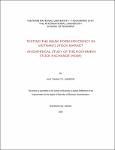| dc.description.abstract | After a booming period of 2006-2007, the first stock bubble in Vietnam
just crashed in late 2007. Consequently, the market experienced a long correction
before having slowly recovered since mid-year 2008. This observation raises a
question about the efficiency level of the Vietnamese stock market, especially after
the event of bubble burst. This paper examines the weak-form Efficient Market
Hypothesis in Vietnam’s stock market within the scope of the Hochiminh Stock
Exchange (HOSE) and four individual stocks listed in the HOSE, including AGF,
HAP, REE, and SAM during the period August 2002 - May 2009. The conventional
autocorrelation test is applied to justify whether weekly price changes in the HOSE
and the selected stocks follow a random walk or not. It is concluded that the
Vietnamese stock market is generally weak-form inefficient due to inherent
imperfection in the market’s operation and investors’ psychology. Consequently, it is
possible to forecast future price changes of VNINDEX and the four selected stocks
based solely on their past price changes. However, the movements of market index
and the selected stocks seem more difficult to be predicted after the event of stock
bubble crash. | en_US |


